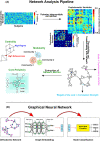Complexity and data mining in dental research: A network medicine perspective on interceptive orthodontics
- PMID: 34519158
- PMCID: PMC9292769
- DOI: 10.1111/ocr.12520
Complexity and data mining in dental research: A network medicine perspective on interceptive orthodontics
Abstract
Procedures and models of computerized data analysis are becoming researchers' and practitioners' thinking partners by transforming the reasoning underlying biomedicine. Complexity theory, Network analysis and Artificial Intelligence are already approaching this discipline, intending to provide support for patient's diagnosis, prognosis and treatments. At the same time, due to the sparsity, noisiness and time-dependency of medical data, such procedures are raising many unprecedented problems related to the mismatch between the human mind's reasoning and the outputs of computational models. Thanks to these computational, non-anthropocentric models, a patient's clinical situation can be elucidated in the orthodontic discipline, and the growth outcome can be approximated. However, to have confidence in these procedures, orthodontists should be warned of the related benefits and risks. Here we want to present how these innovative approaches can derive better patients' characterization, also offering a different point of view about patient's classification, prognosis and treatment.
Keywords: artificial intelligence; big data; complexity; machine learning; musculoskeletal magnetic resonance imaging; network medicine; orthodontics.
© 2021 The Authors. Orthodontics & Craniofacial Research published by John Wiley & Sons Ltd.
Conflict of interest statement
The authors have no conflict of interests to declare.
Figures





References
-
- Polimeni A. Pediatric Dentistry (2nd Ed). Edra (Ed); 2020.
-
- Yan G, Tsekenis G, Barzel B, Slotine JJ, Liu YY, Barabási AL. Spectrum of controlling and observing complex networks. Nat Phys. 2015;11:779‐786. 10.1038/nphys3422 - DOI
-
- Scale‐Free CG. Networks: Complex Webs in Nature and Technology. Oxford University Press; 2007. 10.1093/acprof:oso/9780199211517.001.0001 - DOI
Publication types
MeSH terms
LinkOut - more resources
Full Text Sources
Medical

